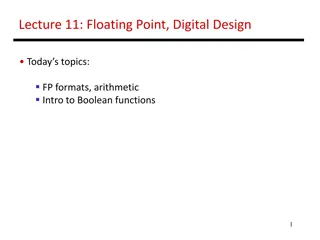Understanding Floating Point Numbers in Computer Science
Exploring the concepts of floating point format, normalization, conversion processes, and IEEE 754 standard for representing floating point numbers in computer systems. Learn about two's complement, excessive notation, and the components that make up a floating point number. Dive into examples of converting numbers to normalized base 8 and base 2 formats. Understand the challenges of comparing floating point numbers due to their infinite representations.
Uploaded on Oct 07, 2024 | 0 Views
Download Presentation

Please find below an Image/Link to download the presentation.
The content on the website is provided AS IS for your information and personal use only. It may not be sold, licensed, or shared on other websites without obtaining consent from the author. Download presentation by click this link. If you encounter any issues during the download, it is possible that the publisher has removed the file from their server.
E N D
Presentation Transcript
ITEC 352 Lecture 8 Floating point format
Review Two s complement Excessive notation Introduction to floating point Floating point numbers
Outline Floating point conversion process Floating point numbers
Standards What are the components that make up a floating point number? How would you represent each piece in binary? Floating point numbers
Why? Consider class floatTest { public static void main(String[] args) { double x = 10; double y=Math.sqrt(x); y = y * y; if (x == y) System.out.println("Equal"); else System.out.println("Not equal"); } } Floating point numbers
Normalization 254 can be represented as: 2.54 * 102 25.4 * 101 .254 * 10-1 There are infinitely many other ways, which creates problems when making comparisons, with so many representations of the same number. Floating point numbers are usually normalized, in which the radix point is located in only one possible position for a given number. Usually, but not always, the normalized representation places the radix point immediately to the left of the leftmost, nonzero digit in the fraction, as in: .254X 103. Floating point numbers
Example Represent .254X 103 in a normalized base 8 floating point format with a sign bit, followed by a 3-bit excess 4 exponent, followed by four base 8 digits. Step #1: Convert to the target base. .254X103 = 25410. Using the remainder method, we find that 25410 = 376X80: 254/8 = 31 R 6 31/8 = 3 R 7 3/8 = 0 R 3 Step #2: Normalize: 376X80 = .376X83. Step #3: Fill in the bit fields, with a positive sign (sign bit = 0), an exponent of 3 + 4 = 7 (excess 4), and 4-digit fraction = .3760: 0 111 . 011 111 110 000 Floating point numbers
Example Convert (9.375 * 10-2)10 to base 2 scientific notation Start by converting from base 10 floating point to base 10 fixed point by moving the decimal point two positions to the left, which corresponds to the -2 exponent: .09375. Next, convert from base 10 fixed point to base 2 fixed point: .09375 * 2 = 0.1875 .1875 * 2 = 0.375 .375 * 2 = 0.75 .75 * 2 = 1.5 .5 * 2 = 1.0 Thus, (.09375)10 = (.00011)2. Finally, convert to normalized base 2 floating point: .00011 = .00011 * 20 = 1.1 * 2-4 Floating point numbers
IEEE 754 standard Defines how to represent floating point numbers in 32 bit (single precision) and 64 bit (double precision). 32 bit is the float type in java. 64 bit is the double type in java. The method: doubleToLong in Java displays the floating point number in IEEE standard. Floating point numbers
Considerations IEEE 754 standard also considers the following numbers: Negative numbers. Numbers with a negative exponent. It also optimizes representation by normalizing the numbers and using the concept of hidden 1 Floating point numbers
Hidden 1 What is the normalized representation of the following: 0.00111 1.00010 100.100 Floating point numbers
Hidden 1 What is the normalized representation of the following: 0.00111 = 1.11 * 2-3 1.00010 = 1.00 * 20 100.100 = 1.00 * 22 Common theme: the digit to the left of the . is always 1!! So why store this in 32 or 64 bits? This is called the hidden 1 representation. Floating point numbers
Negative thoughts IEEE 754 representation uses the following conventions: Negative significand use sign magnitude form. Negative exponent use excess 127 for single precision. Floating point numbers
IEEE-754 Floating Point Formats Floating point numbers
IEEE-754 Examples Floating point numbers
IEEE-754 Conversion Example Represent -12.62510 in single precision IEEE-754 format. Step #1: Convert to target base. -12.62510 = -1100.1012 Step #2: Normalize. -1100.1012 = -1.1001012 * 23 Step #3: Fill in bit fields. Sign is negative, so sign bit is 1. Exponent is in excess 127 (not excess 128!), so exponent is represented as the unsigned integer 3 + 127 = 130. Leading 1 of significand is hidden, so final bit pattern is: 1 1000 0010 . 1001 0100 0000 0000 0000 000 Floating point numbers
Binary coded decimals Many systems still use decimal s for computation, e.g., older calculators. Representation of decimals in such devices: Use binary numbers to represent them (called Binary coded decimals) BCD representation uses 4 digits. 0 = 0000 9 = 1001 Floating point numbers
Summary IEEE floating point Floating point numbers























